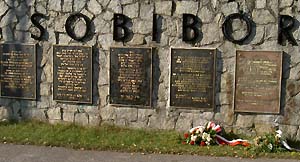|
|
||
|
Sobibor was built in March 1942 near the small village of Sobibor by a railroad station in the far east of Poland. It had to be located in a low populated are because of Operation Reinhard. Sobibor was about 1,300 by 2,000 feet or 400 by 600 meters in size. It was surrounded by a fence that was nine feet tall and was covered by a barbed wire. Along the fence stood several watchtowers. |
||
|
Sobibor was divided into four camps. The administration area, the reception area, the extermination area, and the ammunition area. The administration are had an entrance gat, a railway ramp, and living places for the SS men and the Ukrainians and also kept the Jewish prisoners who worked in Sobibor. In the reception area the Jews who came to Sobibor had to go to this area first. They had to undress here and leave behind all their clothes and valuables. If the Jews tried to hide their valuables or cash they were shot and killed. There a long tube about 150 meters long that connected the reception area to the extermination area. In the extermination area was the gas chambers, burial pits, and places for the Jews to sleep and some of the guards to live. The ammunition area was built on July 5, of 1943 after the camp was converted into a concentration camp. In this area the SS men kept their ammunition stored here. Next to the tube that connected the reception area and the extermination area was a cow shed, a pigsty, a chicken pen, and a shed known as the "hairdresser" where the Jewish women went to have their hair shaven off before entering the gas chambers. |
||
|
Sobibor had three gas chambers that could hold up to about 160-180 people at a time. The buildings were made of brick and had a concrete flooring. The chambers were in the northwest part of the camp. Each chamber had two doors. One of the doors was for the Jews to walk into and the other one was to remove the dead bodies. Carbon monoxide was put through pipes into the chambers and was generated by a diesel engine outside of the buildings. |
||
|
||
|
About 1,000 Jews were chosen to form work teams to work towards the camp staff and the processing of the victims. The work teams worked in the gas chambers and burial pits. They had to clean out the chambers and take out any gold teeth from the dead bodies and then push the bodies in trolleys towards the burial pits. The Jews also had to work in the shaving hut, the undressing rooms, and the sorting sheds. |
||
|
The SS men had several ways to kill or torture the Jews. The gas chambers were not the only way to kill the Jews. Some of the SS men gave Jews umbrellas and pushed them off roof tops like parachuting. Other SS men stabbed the Jews in their back with small knives while the Jews were bent over working. Babies were thrown in garbage pans or torn apart down the middle by their legs. To get the Jews into the chambers the SS men had a dog named Barry that was trained to bite Jews while they were naked. The older and sicker Jews were told that they were being taken to get medical treatment but instead they were throw in ditches where they were shot. |
||
|
By the summer of 1943 Eliezer Kartatt was a witness to the arrival of a transport of Jews:
Ada Lichtmann was a survivor from Sobibor that recalled some of his experiences:
|
||
|
|
||
|
In February of 1943 Himmler visited the camp and ordered it to be changed into a concentration camp. After that the Jewish workers planned to escape. The escape was led by Leon Feldhendler. He was later partnered with Alexander Pechersky, a Jewish officer and Red Army POW. The escape plan happened on October 14, 1943. Eleven SS men and several Ukraine guards were killed. Of the three hundred Jews that escaped most of them were killed in the mine fields or were hunted down and killed by guards. Only fifty Jewish workers lived till the end of the war. After the revolt Himmler decided not to turn Sobibor into a concentration camp and ordered the camp to be destroyed. |
||
|
|
||
|
After Sobibor was torn down eleven SS men were brought to trial in Hagen West Germany from September 6, 1965 to December 20, 1966. One out of the eleven SS men committed suicide, another one was given life imprisonment; five had to three to eight years in prison and four were let off with no punishment. |
||
|
|
||
|
Sobibor was torn down and made to look like a farm. In 1961 a memorial and a museum were built and it is now a Polish National Shrine |


